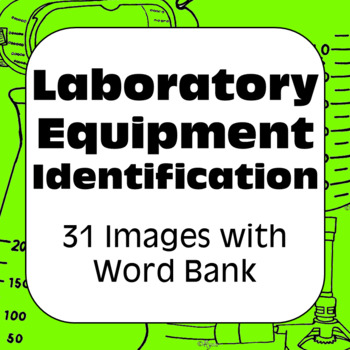Science Lab Equipment Identification ~Original~ for Chemistry/Physical Science
- PDF
- Easel Activity
- Easel Assessment
Also included in
- The original lab equipment identification worksheets & images!Everything you need for chemistry, physical science, biology and AP chemistry & AP biology.Includes:Lab Equipment Identification #1:beaker, chemical gloves, chemical splash goggles, cork stoppers, dropper bottle, dropping pipette,Price $28.80Original Price $32.00Save $3.20
- Please see individual files for additional details. Click here to follow my store and receive the latest updates.Original Artwork (©AwesomeScience). For Personal Use Only. Uneditable.Page count does not include Terms of Use and links to supplementary activities. Copyright ©AwesomeScience 2013 – ThePrice $117.45Original Price $130.50Save $13.05
- Lab Equipment Identification #1 contains the following pieces of equipment:beaker, chemical gloves, chemical splash goggles, cork stoppers, dropper bottle, dropping pipette, electronic balance, Erlenmeyer flask, eye wash station, face shield, fire blanket, fire extinguisher, forceps, graduated cylinPrice $21.60Original Price $24.00Save $2.40
- Lab Equipment Identification #2 contains the following pieces of equipment:Beaker tongs, Bunsen burner, Bunsen burner hose, Crucible & lid, Crucible tongs, Evaporating dish, Flask tongs, Flint lighter, Funnel, Glass plate, Glass stirring rod, Hot plate/Stir plate, Microscope, Mortar & PestlePrice $21.60Original Price $24.00Save $2.40
- Lab Equipment Identification #3 contains the following pieces of equipment:Alcohol burner, Analytical balance, Büchner funnel, Buret, Centrifuge tubes, Deflagrating spoon, Florence flask, Graduated pipet, Inoculating loop, Liebig condenser, Magnetic stir bars & retriever, Pinch clamps, Pipet bulPrice $21.60Original Price $24.00Save $2.40
- Lab Equipment Identification #4 contains the following pieces of equipment:Alcohol burner, Bent forceps, Centrifuge tubes, Depression slides, Dissecting microscope, Dissecting pins, Dissection probe, Dissection scissors, Dissection tray, Examination gloves, Inoculating loop, Lab apron, Lab coat, LabPrice $21.60Original Price $24.00Save $2.40
Description
This two page worksheet containing a word bank and 31 images of lab equipment may be used as a scavenger hunt activity, assignment, or quiz.
Purchase of this product also includes TpT Easel Activity and three auto-grading Easel assessments (students may self-check their work using this tool). All answers included. Original Artwork.
Lab Equipment Identification contains the following:
beaker, beaker Tongs, Bunsen burner, clay triangle, crucible & cover, crucible tongs, dropping pipette (eyedropper), Erlenmeyer flask, evaporating dish, flask tongs, flint lighter, funnel, glass stirring rod, graduated cylinder, mortar & pestle, petri dish & cover, retort stand, ring clamp, rubber stoppers, safety goggles, scoopula, spot plate, test tube, test tube clamp, test tube holder, test tube rack, thermometer, thermometer clamp, tweezers, watch glass, wire mesh.
Related products you may also be interested in:
Lab Safety & General Science Lab Equipment #1
Tarsia Puzzle - Identification
Card Sort - Structure, Function, Form, & Technique
Tarsia Puzzle - Structure, Function, Form, & Technique
Chemistry / Physical Science Lab Equipment #2
Tarsia Puzzle - Identification
Card Sort - Structure, Function, Form, & Technique
Tarsia Puzzle - Structure, Function, Form, & Technique
High School Chemistry Lab Equipment #3
Tarsia Puzzle - Identification
Card Sort - Structure, Function, Form, & Technique
Tarsia Puzzle - Structure, Function, Form, & Technique
High School Biology Lab Equipment #4
Tarsia Puzzle - Identification
Card Sort - Structure, Function, Form, & Technique
Tarsia Puzzle - Structure, Function, Form, & Technique
Click here to follow my store and receive the latest updates.
Original Artwork (©AwesomeScience). For Personal Use Only. Uneditable.
Page count does not include Terms of Use and links to supplementary activities.
Copyright ©AwesomeScience 2013 – The Present.
All Rights Reserved by Author.
By using this Resource you agree to the Terms as outlined in the Terms of Service. This Resource is for limited Personal Use only; not to be used, in part or in whole, for commercial purposes. Each Individual License is for use by one specific educator only. Additional licenses must be purchased for each additional educator. Except as permitted in Section 3 to deliver Resources electronically to Permitted Recipients, you may not post or otherwise make the Resource available on any website, application, shared drive or other sites or services.










